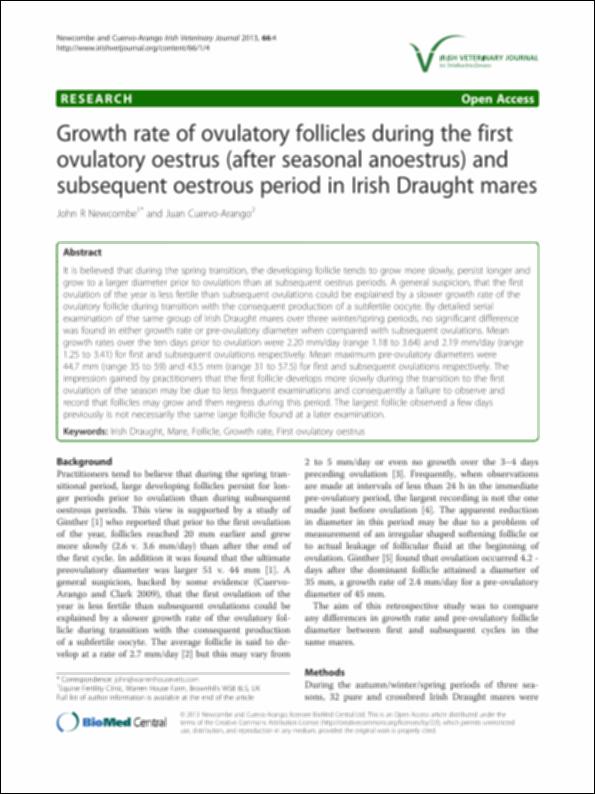Please use this identifier to cite or link to this item:
http://hdl.handle.net/10637/14493Growth rate of ovulatory follicles during the first ovulatory oestrus (after seasonal anoestrus) and subsequent oestrous period in Irish Draught mares
| Title: | Growth rate of ovulatory follicles during the first ovulatory oestrus (after seasonal anoestrus) and subsequent oestrous period in Irish Draught mares |
| Authors : | Newcombe, John R. Cuervo-Arango Lecina, Juan |
| Keywords: | Horses - Generative organs.; Horse breeds - Irish Draught.; Estro.; Estrus.; Caballos - Razas - Caballo de tiro irlandés.; Caballos - Reproducción.; Ovulación.; Ovulation.; Caballos - Aparato genital.; Horses - Reproduction. |
| Publisher: | BioMed Central |
| Citation: | Newcombe, J. R. & Cuervo-Arango, J. (2013). Growth rate of ovulatory follicles during the first ovulatory oestrus (after seasonal anoestrus) and subsequent oestrous period in Irish Draught mares. Irish Veterinary Journal, vol. 66, i. 1 (12 mar.), art. 4. DOI: https://doi.org/10.1186/2046-0481-66-4 |
| Abstract: | It is believed that during the spring transition, the developing follicle tends to grow more slowly, persist longer and grow to a larger diameter prior to ovulation than at subsequent oestrus periods. A general suspicion, that the first ovulation of the year is less fertile than subsequent ovulations could be explained by a slower growth rate of the ovulatory follicle during transition with the consequent production of a subfertile oocyte. By detailed serial examination of the same group of Irish Draught mares over three winter/spring periods, no significant difference was found in either growth rate or pre-ovulatory diameter when compared with subsequent ovulations. Mean growth rates over the ten days prior to ovulation were 2.20 mm/day (range 1.18 to 3.64) and 2.19 mm/day (range 1.25 to 3.41) for first and subsequent ovulations respectively. Mean maximum pre-ovulatory diameters were 44.7 mm (range 35 to 59) and 43.5 mm (range 31 to 57.5) for first and subsequent ovulations respectively. The impression gained by practitioners that the first follicle develops more slowly during the transition to the first ovulation of the season may be due to less frequent examinations and consequently a failure to observe and record that follicles may grow and then regress during this period. The largest follicle observed a few days previously is not necessarily the same large follicle found at a later examination. |
| Description: | Este artículo se encuentra disponible en la siguiente URL: https://irishvetjournal.biomedcentral.com/articles/10.1186/2046-0481-66-4 |
| URI: | http://hdl.handle.net/10637/14493 |
| Rights : | http://creativecommons.org/licenses/by/4.0/deed.es |
| ISSN: | 2046-0481 |
| Language: | es |
| Issue Date: | 12-Mar-2013 |
| Center : | Universidad Cardenal Herrera-CEU |
| Appears in Collections: | Dpto. Medicina y Cirugía Animal |
Items in DSpace are protected by copyright, with all rights reserved, unless otherwise indicated.


